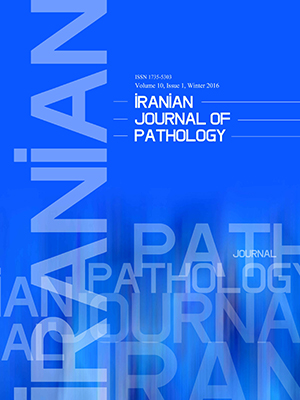Document Type : Original Research
Authors
1 Dept. of Immunology, Medical School, Kermanshah University of Medical Sciences, Kermanshah, Iran
2 Dept. of Anatomy, Medical School, Kermanshah University of Medical Sciences, Kermanshah, Iran
3 Medical Biology Research Center, Kermanshah University of Medical Sciences, Kermanshah, Iran
4 Dept. of Microbiology & Immunology, Medical School, Alborz University of Medical Sciences, Karaj, Iran
Abstract
Background and Objectives: Multiple sclerosis is an inflammatory disease of the central nervous system. This is due to migration of peripherally activated lymphocytes to central nervous system leading to inflammatory lesions. However, liver has an anti-inflammatory microenvironment. Myelin expression in the liver of transgenic mice suppresses inflammatory lesions within central nervous system. Considering the notion that the inflammatory events originate from periphery, we investigated if the liver was affected in an animal model for multiple sclerosis. Methods: Experimental autoimmune encephalomyelitis was induced in male Lewis rats using guinea pig spinal cord and complete Freund's adjuvant. Weight, clinical score, and survival rate were evaluated for 14 days post immunization. Liver sections were taken and stained with Hematoxylin and Eosin and examined with an Olympus microscope. Results: Mortality was accompanied by liver damage. Sinusoidal congestion, pycnotic nuclei within hepatocytes, hepatocyte necrosis, and severe widespread congestion along with fat accumulation within hepatocytes (fatty degeneration) were observed in liver tissue sections. Conclusion: Liver damage occurs in experimental autoimmune encephalomyelitis. The perpetuation of self antigen leading to continuous migration of extrahepatically activated T cells makes an inflammatory milieu in the liver. It follows migration and development of more inflammatory cells and may paralyses tolerance inducing mechanisms. Apart from central nervous system lesion, liver injury may act as synergistic factor for debilitation and mortality.
Keywords
- Hauser SL, Oksenberg JR. The neurobiology of multiple sclerosis: genes, inflammation, and neurodegeneration. Neuron 2006; 52(1):61-76.
- Lisak RP, Zweiman B. In vitro cell-mediated immunity of cerebrospinal-fluid lymphocytes to myelin basic protein in primary demyelinating diseases. N Engl J Med 1977; 297(16):850-3.
- Kurtzke JF, Hyllested K. Multiple sclerosis in the Faroe Islands: I. clinical and epidemiological features. Ann Neurol 1979; 5(1):6-21.
- Cabre P, Signate A, Olindo S, Merle H, Caparros-Lefebvre D, Béra O, et al. Role of return migration in the emergence of multiple sclerosis in the French West Indies. Brain 2005; 128(pt 12):2899-910.
- Frohman EM, Racke MK, Raine CS. Multiple sclerosis: the plaque and its pathogenesis. N Engl J Med 2006; 354(9):942-55.
- Carrier P, Godet B, Crepin S, Magy L, Debette-Gratien M, Pillegand B, et al. Acute liver toxicity due to methylprednisolone: consider this diagnosis in the context of autoimmunity. Clin Res Hepatol Gastroenterol 2013; 37(1):100-4.
- Tamura S, Warabi Y, Matsubara S. Severe liver dysfunction possibly caused by the combination of interferon beta-1b therapy and melilot (sweet clover) supplement. J Clin Pharm Ther 2012; 37(6):724-5.
- Lisotti A, Azzaroli F, Brillanti S, Mazzella G. Severe acute autoimmune hepatitis after natalizumab treatment. Dig Liver Dis 2012; 44(4):356-7.
- Subramaniam K, Pavli P, Llewellyn H, Chitturi S. Glatiramer acetate induced hepatotoxicity. Curr Drug Saf 2012; 7(2):186-8.
- Larijani B, Esfahani EN, Amini P, Nikbin B, Alimoghaddam K, Amiri S, et al. Stem cell therapy in treatment of different diseases. Acta Med Iran 2012; 50(2):79-96.
- Prinz-Hadad H, Mizrachi T, Irony-Tur-Sinai M, Prigozhina TB, Aronin A, Brenner T, et al. Amelioration of autoimmune neuroinflammation by the fusion molecule Fn14·TRAIL. J Neuroinflammation 2013; 10:36-46.
- Cantor HM, Dumont AE. Hepatic suppression of sensitization to antigen absorbed into the portal system. Nature 1967; 215(5102):744–5.
- Racanelli V, Rehermann B. The liver as an immunological organ. Hepatology 2006; 43(2 Suppl 1):S54-62.
- Bertolino P, Bowen DG, McCaughan GW, Fazekas De St Groth B. Antigen-specific primary activation of CD8(+) T cells within the liver. J Immunol 2001; 166(5):5430–8.
- Liu ZX, Govindarajan S, Okamoto S, Dennert G. Fas-mediated apoptosis causes elimination of virus-specific cytotoxic T cells in the virus-infected liver. J Immunol 2001; 166(5):3035–3041.
- Mehal WZ, Juedes AE, Crispe IN. Selective retention of activated CD8+T cells by the normal liver. J Immunol 1999; 163(6): 3202–10.
- Bradham CA, Plumpe J, Manns MP, Brenner DA, Trautwein C. Mechanisms of hepatic toxicity. I. TNF-induced liver injury. Am J Physiol 1998; 275(3 pt 1):G387–G392.
- Lin JT, Martin SL, Xia L, Gorham JD. TGF-beta 1 uses distinct mechanisms to inhibit IFN-gamma expression in CD4+T cells at priming and at recall: differential involvement of Stat4 and T-bet. J Immunol 2005; 174(10):5950–8.
- Knolle PA, Gerken G, Loser E, Dienes HP, Gantner F, Tiegs G, et al. Role of sinusoidal endothelial cells of the liver in concanavalin A-induced hepatic injury in mice. Hepatology 1996; 24(2):824–9.
- Khandoga A, Hanschen M, Kessler JS, Krombach F. CD4+T cells contribute to postischemic liver injury in mice by interacting with sinusoidal endothelium and platelets. Hepatology 2006; 43(2): 306–15.
- Osman Y, Kawamura T, Naito T, Takeda K, Van Kaer L, Okumura K, et al. Activation of hepatic NKT cells and subsequent liver injury following administration of alpha-galactosylceramide. Eur J Immunol 2000; 30(7):1919–28.
- Toyabe S, Seki S, Iiai T, Takeda K, Shirai K, Watanabe H, et al. Requirement of IL-4 and liver NK1+ T cells for concanavalin A induced hepatic injury in mice. J Immunol 1997; 159(3):1537–42.
- Longhi MS, Ma Y, Mitry RR, Bogdanos DP, Heneghan M, Cheeseman P, et al. .Effect of CD4+CD25+ regulatory T-cells on CD8 T-cell function in patients with autoimmune hepatitis. J Autoimmun 2005; 25(1):63–71.
- Lüth S, Huber S, Schramm C, Buch T, Zander S, Stadelmann C, et al. Ectopic expression of neural autoantigen in mouse liver suppresses experimental autoimmune neuroinflammation by inducing antigen-specific Tregs. J Clin Invest 2008; 118(10):3403-10.
- Tremlett H, Seemüller S, Zhao Y, Yoshida EM, Oger JD, Petkau J. Liver test abnormalities in multiple sclerosis: findings from placebo-treated patients. Neurology 2006 10; 67(7):1291-3.

